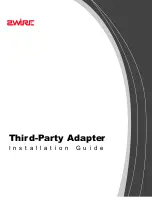
Partition Naming Scheme
271
created during the resizing process.
Figure 26.13, “Disk Drive with Final Partition Configuration”
,
shows this being done.
Figure 26.13. Disk Drive with Final Partition Configuration
In
Figure 26.13, “Disk Drive with Final Partition Configuration”
,
1
represents before and
2
represents
after.
Note
The following information is specific to x86-based computers only.
As a convenience to our customers, we provide the
parted
utility. This is a freely available program
that can resize partitions.
If you decide to repartition your hard drive with
parted
, it is important that you be familiar with disk
storage and that you perform a backup of your computer data. You should make two copies of all the
important data on your computer. These copies should be to removable media (such as tape, CD-
ROM, or diskettes), and you should make sure they are readable before proceeding.
Should you decide to use
parted
, be aware that after
parted
runs you are left with
two
partitions:
the one you resized, and the one
parted
created out of the newly freed space. If your goal is to use
that space to install Red Hat Enterprise Linux, you should delete the newly created partition, either by
using the partitioning utility under your current operating system or while setting up partitions during
installation.
26.1.5. Partition Naming Scheme
Linux refers to disk partitions using a combination of letters and numbers which may be confusing,
particularly if you are used to the "C drive" way of referring to hard disks and their partitions. In the
DOS/Windows world, partitions are named using the following method:
• Each partition's type is checked to determine if it can be read by DOS/Windows.
• If the partition's type is compatible, it is assigned a "drive letter." The drive letters start with a "C" and
move on to the following letters, depending on the number of partitions to be labeled.
• The drive letter can then be used to refer to that partition as well as the file system contained on that
partition.
Red Hat Enterprise Linux uses a naming scheme that is more flexible and conveys more information
than the approach used by other operating systems. The naming scheme is file-based, with file names
in the form of
/dev/
xxyN
.
Here is how to decipher the partition naming scheme:
Содержание ENTERPRISE LINUX 5 - VIRTUAL SERVER ADMINISTRATION
Страница 12: ...xii ...
Страница 20: ......
Страница 30: ...12 ...
Страница 32: ...14 ...
Страница 82: ...64 ...
Страница 106: ...88 ...
Страница 122: ...104 ...
Страница 124: ...106 ...
Страница 126: ......
Страница 132: ...114 ...
Страница 168: ...150 ...
Страница 182: ...164 ...
Страница 192: ...174 ...
Страница 194: ......
Страница 236: ...218 ...
Страница 238: ...220 ...
Страница 270: ......
Страница 274: ...256 ...
Страница 278: ...260 ...
Страница 292: ...274 ...
Страница 294: ......
Страница 300: ...282 ...
Страница 304: ......
Страница 316: ...298 ...
Страница 357: ...Creating Partitions 339 Figure 32 7 Creating a Software RAID Device 4 Click OK to add the device to the list ...
Страница 370: ...352 ...
Страница 384: ...366 ...
Страница 385: ...Part VII Appendix ...
Страница 386: ......
















































